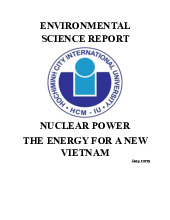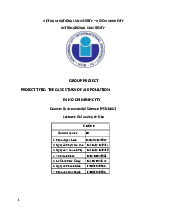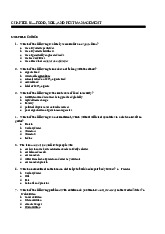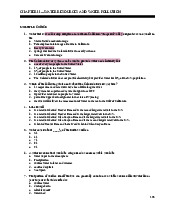



















Preview text:
Lecture ENVIRONMENTAL SCIENCE
Prepared by Dr. NGUYEN Ngoc Vinh 1
8. Food Production and the Environment
1. What isfood security and why is it difficult to attain?
2. How isfood produced? 3. What environmental problems arise from food production?
4. How can we protect cropsfrompests moresustainably?
5. How can we improvefood security?
6. How can we produce food moresustainably? 2
is it difficult to attain?
8.1. What is food security and why Concept8.1A
Many of the poor suffer health problems from chronic lack of
food and poor nutrition, while many people in developed
countries havehealth problemsfromeating too much food. Concept8.1B
The greatest obstacles to providing enough food for everyone are
poverty, political upheaval, corruption, war, and the
harmfulenvironmentaleffects offood production. 3
8.1 What Is Food Security and Why Is It Difficult To Attain?
• In less developed countries, people suffer from
health problems associated with not getting enough to eat
• In more developed countries, others suffer
health problems from having too much to eat
• Factors influencing food supply: poverty, war,
bad weather, climate change, and effects of
industrialized food production
Poverty Is the Root Cause of Food Insecurity 1
• Scientists project that by 2050, we will need to
feed at least 9.7 billion people, almost half of
which live in poverty and experience food insecurity
– How do we feed more people without seriously harming the environment?
• Many people suffer from chronic hunger and
malnutrition and don’t get enough vitamins and minerals Malnutrition
• Low income, less developed countries: diets
center on high carbohydrate grains and very little protein
• Food deserts (no access to fresh food) in
developed countries: diets high in fat, sugar, salt, and little protein
• Almost 2 billion people suffer from a
deficiency of micronutrients (vitamin A, iron, and iodine) 2
8.2 . How is food produced? Concept8.2A
We have sharply increased crop production using a mix of
industrialized and traditionalagriculture. Concept8.2B
We have used industrialized and traditional methods to greatly
increasesupplies of meat, fish, and shellfish. 7
8.2 How Is Food Produced?
• Today, agriculture uses both high input
industrialized, and low input traditional
methods, to produce the world’s food supply 3
Industrialized and Traditional Crop Production
• Industrialized/high input agriculture: heavy equipment, fossil fuel, commercial
fertilizer/pesticides, and money (monoculture: growing one to two crops)
– Food supply vulnerable to disease
• Traditional/low input agriculture: solar energy
and human labor to grow a crop that will feed
a family with no surplus (polyculture: growing several crops)
Differences Between Industrialized and Organic Agriculture
Organic Agriculture and the Green Revolution 4
• Organic agriculture: crops grown without the
use of synthetic pesticides and inorganic
fertilizers, or genetic engineering
• Green revolution: higher yields from existing cropland
– Plant monocultures of selectively bred crops
– Large amounts of water; synthetic fertilizers and pesticides – Multiple cropping
Food Demands, Consumption, and Rising
Industrialized Productivity
• The increasing demand for food is being met by increases in production
– New and hardier crop varieties are being developed
by second gene revolution methodology (gene splicing)
– Meat production now uses feedlots as well as rangelands and pastures
– Aquaculture produces more fish and is the world’s
fastest growing type of food production
Industrialized Food Production Requires Huge Inputs of Energy 5
• Large inputs of energy are needed to grow, store, process, package, transport,
refrigerate, and cook plants and animals
– In the U.S., 10 units of fossil fuel energy are
needed to produce 1 unit of food energy
– Fishing fleets use 12.5 units of energy to produce 1 unit of energy from seafood
– Industrialized food production is dependent on
fossil fuel, resulting in a net energy loss
from industrialized food production?
8.3. What environmental problems arise Concept8.3
Food production in the future may be limited by its serious
environmental impacts, including soil erosion and degradation,
desertification, water and air pollution, greenhouse gas
emissions,and degradation and destruction ofbiodiversity. 14
8.3 What Environmental Problems Arise from
Industrialized Food Production? 6
• Soil erosion, desertification, irrigation, water
shortages, air and water pollution, climate
change and loss of biodiversity may limit future food production
Producing Food Has Major Environmental Impacts
• While industrialized agriculture has
allowed farmers to use less land to
produce more food, it is environmentally
and economically unsustainable
– Industrialized agriculture:
• Removes 70% of fresh water from surface sources and aquifers
• Uses 38% of the world’s ice-free land
• Emits 25% of all greenhouse gas emissions
• Produces 60% of all water pollution
Topsoil Erosion Is a Serious Problem in Parts of the World 7
• Topsoil (the fertile top layer of many soils), is a
significant natural capital component because
it stores water and nutrients needed by plants
• Topsoil renewal is one of the earth’s most important ecosystem services
– Topsoil nutrients recycle endlessly as long as they
are not removed faster than natural processes replace them
Generalized Soil Profile Soil Erosion 8
• The movement of soil from one place to another
by nature and by human activity
– Flowing water (the largest cause of soil erosion)
carries away soil loosened by rainfall
– Wind loosens and blows away topsoil particles –from flat land in dry climates
– Farming, deforestation, and overgrazing exposes land and hastens soil erosion
Harmful Affects of Soil Erosion
• Loss of soil fertility through the depletion of plant nutrients in topsoil
• Topsoil pollution of surface waters can kill fish and clog reservoirs and lakes
– Increased if it contains pesticide residues –
biomagnified through food webs
• Erosion releases the soil’s carbon content,
which alters the carbon cycle, adding to atmospheric levels of CO2
Natural Capital Degradation: Topsoil Erosion 9 Agricultural Activities Have Serious
Environmental Consequences
• Irrigation boosts/lowers farm productivity
– 20% of the world’s irrigated crop land produces
about 40% of the world’s food
– Irrigation water has a variety of salts, which leads to soil salinization
• Livestock production generates 18% of all greenhouse gas
• Fertilizer use releases nitrous oxide, increasing atmospheric temperatures
Harmful Environmental Effects of Food Production 10
Biodiversity Loss During Food Production
• Clearing and burning forests leads to the loss of natural biodiversity
• Deforestation in the Amazon Basin and
clearing of grasslands for cattle ranching and
plantation farming (sugar cane) decreases biodiversity
– As fewer varieties of plant and animal species are
used in farming, agrobiodiversity decreases
Are There Limits To the Expansion of the Green Revolutions? 11
• Genetically modified (GM) food production is
controversial, with benefits/drawbacks
• Genetically engineered crop yields seem to be
no higher than for traditional strains
• Population growth, water availability, and
climate change limit irrigation’s potential
• Deforestation speeds up climate change,
increases topsoil erosion, and lowers biodiversity
Tradeoffs of GM Crops and Foods
Harmful Environmental Effects of Industrialized
Meat Production/Aquaculture 12
• Cheap meat produced by industrialized
agriculture has harmful environmental and
health costs not included in pricing – violating
full-cost principle of sustainability
• Fishmeal and fish oil, food sources for farmed
fish (often contaminated with toxins), come
from wild fish caught from the oceans –
biomagnified in human food web; depletes wild fish populations
Tradeoffs: Animal Feedlots and Aquaculture 13 from pests more sustainably?
8.4. How can we protect crops Concept8.4
We can sharply cut pesticide use without decreasing crop yields by
using a mix of cultivation techniques, biological pest controls, and
small amounts of selected chemical pesticides as a last
resort(integrated pest management). 29
8.4 How Can We Protect Crops from Pests More Sustainably?
• Using a mix of cultivation techniques,
biological pest controls, and selective
chemical pesticides (as a last resort) will
enable farmers to sharply decrease pesticide
use without decreasing crop yields 14
Nature Controls the Populations of Most Pests
• Natural enemies control the populations of most pest species
– This free ecosystem service is an important part of earth’s natural capital
• Humans upset the checks and balances of
natural pest control when we clear forests and
grasslands, plant monoculture crops, and use
synthetic chemicals to kill pests
Advantages of Synthetic Pesticide Use
• Human lives have been saved from insect
transmitted disease (especially malaria)
• Food supplies are increased by reducing food loss due to pests
• Crop yields and farming profits increase
• Newer pesticides are safer, more effective, and
work faster – and when properly used, keep
health risks very low relative to benefits
Disadvantages of Synthetic Pesticide Use 15
• The genetic development of pesticide resistance in pest organisms
• Long term usage diminishes effectiveness –
costing farmers more for less return
• Insecticides kill the pest’s natural enemies
• Inefficient application causes pollution
• Both wildlife and human health are affected
Tradeoffs of Conventional Chemical Pesticides
Protective Laws and Treaties 16
• Pesticide usage is regulated by:
– Environmental Protection Agency (EPA), U.S.
Department of Agriculture (USDA), and the Food
and Drug Administration (FDA) under the Federal
Insecticide, Fungicide and Rodenticide Act (FIFRA)
• Unfortunately adequate funding has not been
provided for effective management and enforcement of FIFRA
Alternatives to Synthetic Pesticide Use
• Crop rotation/adjusting planting time starves
pests/allows enemies to eat them
• Polyculture provides homes for pest’s enemies
• Implant genetic resistance
• Biological control: use natural enemies
– Natural pheromones (insect perfume) • Can lure pests into traps
• Can attracted natural enemies into crop fields
More Alternatives to Synthetic Pesticide Usage 17
• Disrupt the life cycles of insects by altering their hormones
– Using insect perfume and hormone alteration are
both time consuming and costly
• Reduce synthetic herbicide usage to control weeds
• Integrated pest management (IPM) – use of a coordinated combination of cultivation, biological and chemical tools
8.5 . How can we improve food security? Concept8.5
We can improve food security by creating programs to reduce
poverty and chronic malnutrition, relying more on locally
grown food,and cutting food waste. 38
8.5 How Can We Improve Food Security? 18
• Reducing poverty and malnutrition, producing
food more sustainably, and relying on locally
sourced food will improve food security
The Government’s Role in Improving Food
Production and Security
• Controlling food prices vs. food subsides
• Implementing health measures
• Aid local, sustainable, organic food production and distribution • Educate farmers
• Encourage Community Supported Agriculture
(CSA) programs and vertical farming 19




